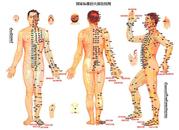AcupunctureAcupuncture is an ancient system of natural healing used for
the past 4,000 years in China, Which is rapidly taking its legitimate place as
a valuable therapeutic technique in modern medicine today. Mythology holds that
acupuncture was discovered when ancient Chinese warriors wounded by arrows in
battle, recovered from illness and pain that affected them for years. These experiences
evolved the idea that puncturing certain sites on the body promotes a natural
healing process. In the early days, some 50 centuries ago, sharp thin stones were used at "acu-points", evolving to thorns, slivers of bamboo, bone, or horn needles. Much later, bronze or iron needles were fashioned.
Interestingly, it was discovered that different metals elicited different effects. Gold was used to stimulate and silver to sedate. In the world, the popular interest in acupuncture motivated by alternative medicine is becoming a fashion. A trend of treatment modality in the healthcare field is combining western medicine and alternative medicine. In USA, acupuncture is now licensed or regulated in over 40 states. In UK, France, Germany, Russia, Japan, and China, acupuncture is utilized in many hospitals. In Canada, the use of acupuncture has also spread into almost every province. There is an estimated 1.5 million practitioners throughout the world! These statistics provide strong testimony that people all over the globe are getting relief through acupuncture. Acupuncture is a complex system of examination, diagnosis, and treatment. It is preventive medicine; it creates and maintains health and is often used as an analgesic first-aid technique that brings relief from pain. Acupuncture is also employed for anaesthetic purposes. Traditional Chinese Medicine is based upon the principle that any symptom is the result of an imbalance in the body's organic, energetic and natural activity. Acupuncture works by opening up the flow of vital energy, also known as "Chi", thereby restoring health to the body. When "Chi" is flowing properly throughout our meridian pathways, all of our processes operate in a rhythmic and harmonious way. |
Chinese Herbal Medicine (CHM)
|

